Persimmon Plc: Financial Performance, Investment, and Cost Analysis
VerifiedAdded on 2023/01/11
|13
|2522
|26
Report
AI Summary
This report provides a comprehensive financial analysis of Persimmon Plc, a leading UK house building company. It begins with an introduction to financial accounting and its relevance to the company's operations. The report then delves into the financial performance of Persimmon Plc, utilizing ratio analysis to assess liquidity, profitability, and efficiency. The analysis covers the years 2018 and 2019, comparing key ratios like current ratio, quick ratio, return on capital employed, return on equity, gross profit margin, and net profit margin. The report also examines investment appraisal techniques, comparing Software project A and Hardware project B using NPV, payback period, and IRR, recommending the more profitable option. Finally, the report explores cost analysis of existing and proposed products using marginal and absorption costing methods, providing recommendations on which product to focus on. The report concludes with recommendations and a discussion of the company's financial health and strategic decisions.
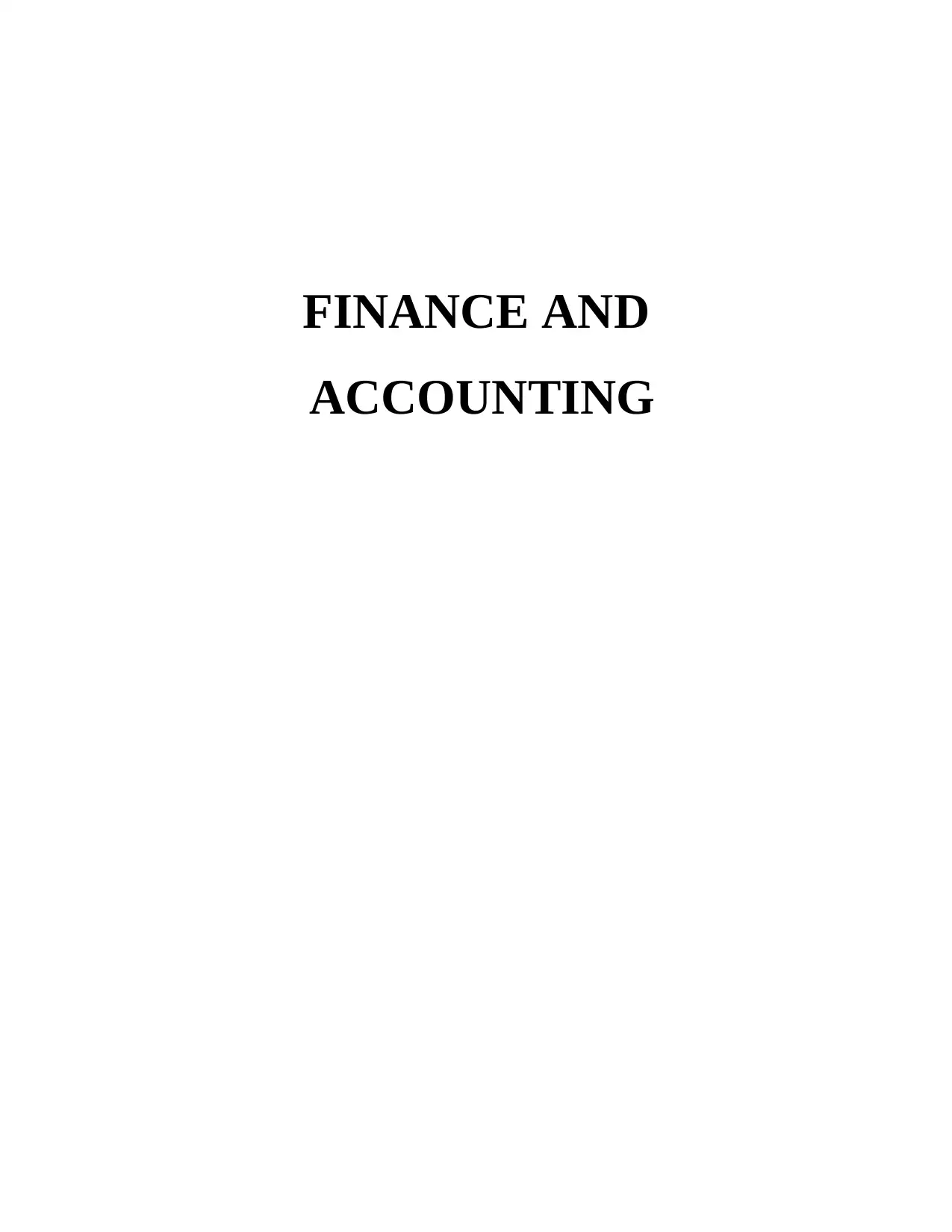
FINANCE AND
ACCOUNTING
ACCOUNTING
Paraphrase This Document
Need a fresh take? Get an instant paraphrase of this document with our AI Paraphraser

TABLE OF CONTENTS
TABLE OF CONTENTS................................................................................................................2
INTRODUTION..............................................................................................................................1
Financial performance of the company using ratio analysis.......................................................1
Appraisal of possible investment and sources of finance............................................................4
Cost analysis of present and proposed products..........................................................................8
CONCLUSION..............................................................................................................................10
REFERENCES..............................................................................................................................11
TABLE OF CONTENTS................................................................................................................2
INTRODUTION..............................................................................................................................1
Financial performance of the company using ratio analysis.......................................................1
Appraisal of possible investment and sources of finance............................................................4
Cost analysis of present and proposed products..........................................................................8
CONCLUSION..............................................................................................................................10
REFERENCES..............................................................................................................................11
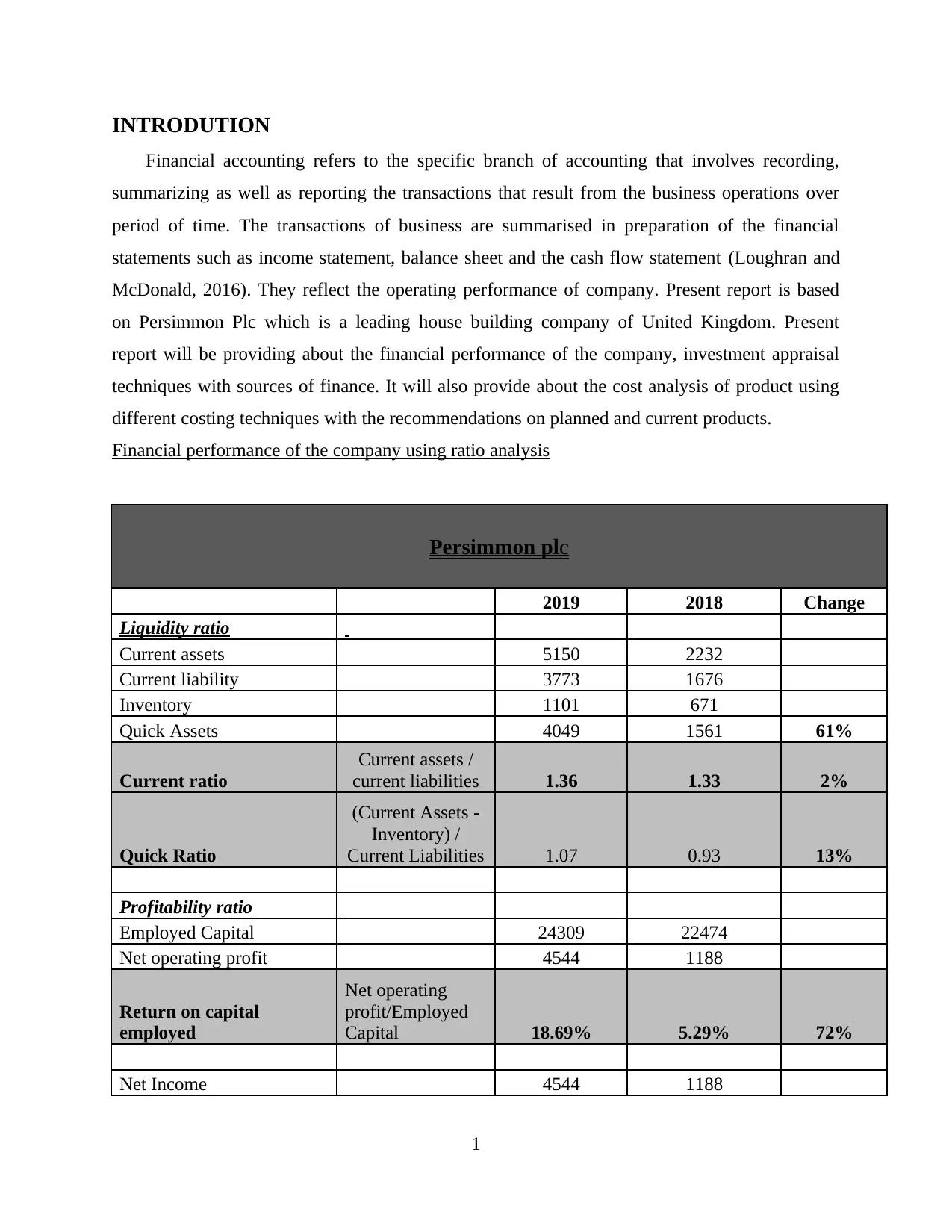
INTRODUTION
Financial accounting refers to the specific branch of accounting that involves recording,
summarizing as well as reporting the transactions that result from the business operations over
period of time. The transactions of business are summarised in preparation of the financial
statements such as income statement, balance sheet and the cash flow statement (Loughran and
McDonald, 2016). They reflect the operating performance of company. Present report is based
on Persimmon Plc which is a leading house building company of United Kingdom. Present
report will be providing about the financial performance of the company, investment appraisal
techniques with sources of finance. It will also provide about the cost analysis of product using
different costing techniques with the recommendations on planned and current products.
Financial performance of the company using ratio analysis
Persimmon plc
2019 2018 Change
Liquidity ratio
Current assets 5150 2232
Current liability 3773 1676
Inventory 1101 671
Quick Assets 4049 1561 61%
Current ratio
Current assets /
current liabilities 1.36 1.33 2%
Quick Ratio
(Current Assets -
Inventory) /
Current Liabilities 1.07 0.93 13%
Profitability ratio
Employed Capital 24309 22474
Net operating profit 4544 1188
Return on capital
employed
Net operating
profit/Employed
Capital 18.69% 5.29% 72%
Net Income 4544 1188
1
Financial accounting refers to the specific branch of accounting that involves recording,
summarizing as well as reporting the transactions that result from the business operations over
period of time. The transactions of business are summarised in preparation of the financial
statements such as income statement, balance sheet and the cash flow statement (Loughran and
McDonald, 2016). They reflect the operating performance of company. Present report is based
on Persimmon Plc which is a leading house building company of United Kingdom. Present
report will be providing about the financial performance of the company, investment appraisal
techniques with sources of finance. It will also provide about the cost analysis of product using
different costing techniques with the recommendations on planned and current products.
Financial performance of the company using ratio analysis
Persimmon plc
2019 2018 Change
Liquidity ratio
Current assets 5150 2232
Current liability 3773 1676
Inventory 1101 671
Quick Assets 4049 1561 61%
Current ratio
Current assets /
current liabilities 1.36 1.33 2%
Quick Ratio
(Current Assets -
Inventory) /
Current Liabilities 1.07 0.93 13%
Profitability ratio
Employed Capital 24309 22474
Net operating profit 4544 1188
Return on capital
employed
Net operating
profit/Employed
Capital 18.69% 5.29% 72%
Net Income 4544 1188
1
⊘ This is a preview!⊘
Do you want full access?
Subscribe today to unlock all pages.

Trusted by 1+ million students worldwide

Shareholder's Equity 15098 13150
Return on Equity
Net Income /
Shareholder's
Equity 30.10% 9.03% 70%
Cost of Sales 5605 4959
Sales 14206 9167
Gross Margin
Total Sales –
COGS/Total Sales 60.54% 45.90% 24%
Net profit 4544 1188
Sales 14206 9167
Net profit ratio
Operating Income/
Net Sales 31.99% 12.96% 59%
Efficiency Ratios
Inventory 1101 671
Trade Receivables 1258 120
Net Assets 15098 13150
Cost of Sales 5605 4959
Sales 14206 9167
Asset turnover ratio Sales / Net assets 0.94 0.70 26%
Inventory turnover ratio Sales / Inventory 5.09 7.39 -45%
Account receivable
turnover ratio
Sales / Accounts
Receivable 11.29 76.39 -576%
Debt
Debt 9211 9324
Equity 15098 13150
Debt equity ratio Debt/ Equity 61.01% 70.90% -16%
Ratio analysis is the tool used by users of the financial statements for assessing the financial
performance of the company. Financial performance of Persimmon Plc is assessed for the year
2018 and 2019.
2
Return on Equity
Net Income /
Shareholder's
Equity 30.10% 9.03% 70%
Cost of Sales 5605 4959
Sales 14206 9167
Gross Margin
Total Sales –
COGS/Total Sales 60.54% 45.90% 24%
Net profit 4544 1188
Sales 14206 9167
Net profit ratio
Operating Income/
Net Sales 31.99% 12.96% 59%
Efficiency Ratios
Inventory 1101 671
Trade Receivables 1258 120
Net Assets 15098 13150
Cost of Sales 5605 4959
Sales 14206 9167
Asset turnover ratio Sales / Net assets 0.94 0.70 26%
Inventory turnover ratio Sales / Inventory 5.09 7.39 -45%
Account receivable
turnover ratio
Sales / Accounts
Receivable 11.29 76.39 -576%
Debt
Debt 9211 9324
Equity 15098 13150
Debt equity ratio Debt/ Equity 61.01% 70.90% -16%
Ratio analysis is the tool used by users of the financial statements for assessing the financial
performance of the company. Financial performance of Persimmon Plc is assessed for the year
2018 and 2019.
2
Paraphrase This Document
Need a fresh take? Get an instant paraphrase of this document with our AI Paraphraser
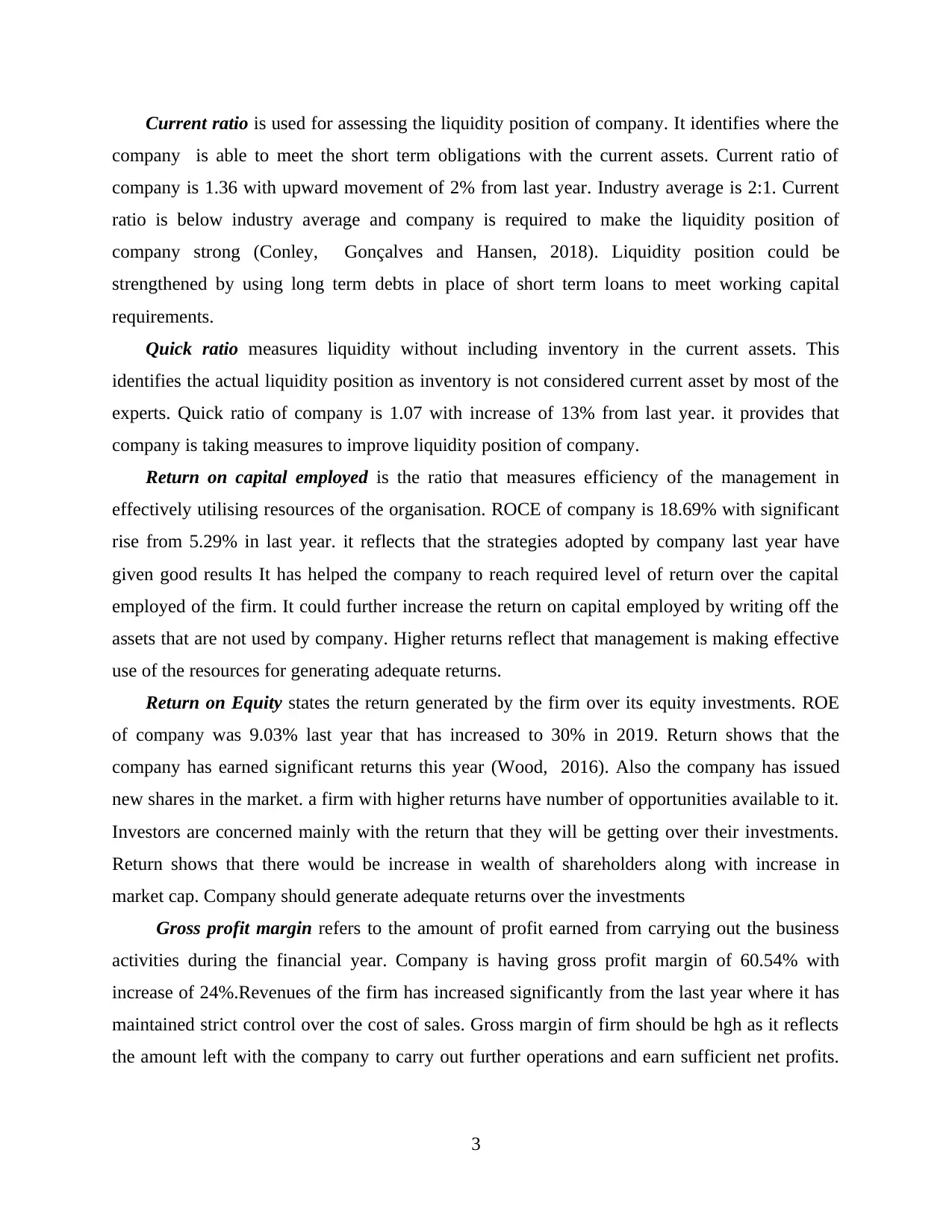
Current ratio is used for assessing the liquidity position of company. It identifies where the
company is able to meet the short term obligations with the current assets. Current ratio of
company is 1.36 with upward movement of 2% from last year. Industry average is 2:1. Current
ratio is below industry average and company is required to make the liquidity position of
company strong (Conley, Gonçalves and Hansen, 2018). Liquidity position could be
strengthened by using long term debts in place of short term loans to meet working capital
requirements.
Quick ratio measures liquidity without including inventory in the current assets. This
identifies the actual liquidity position as inventory is not considered current asset by most of the
experts. Quick ratio of company is 1.07 with increase of 13% from last year. it provides that
company is taking measures to improve liquidity position of company.
Return on capital employed is the ratio that measures efficiency of the management in
effectively utilising resources of the organisation. ROCE of company is 18.69% with significant
rise from 5.29% in last year. it reflects that the strategies adopted by company last year have
given good results It has helped the company to reach required level of return over the capital
employed of the firm. It could further increase the return on capital employed by writing off the
assets that are not used by company. Higher returns reflect that management is making effective
use of the resources for generating adequate returns.
Return on Equity states the return generated by the firm over its equity investments. ROE
of company was 9.03% last year that has increased to 30% in 2019. Return shows that the
company has earned significant returns this year (Wood, 2016). Also the company has issued
new shares in the market. a firm with higher returns have number of opportunities available to it.
Investors are concerned mainly with the return that they will be getting over their investments.
Return shows that there would be increase in wealth of shareholders along with increase in
market cap. Company should generate adequate returns over the investments
Gross profit margin refers to the amount of profit earned from carrying out the business
activities during the financial year. Company is having gross profit margin of 60.54% with
increase of 24%.Revenues of the firm has increased significantly from the last year where it has
maintained strict control over the cost of sales. Gross margin of firm should be hgh as it reflects
the amount left with the company to carry out further operations and earn sufficient net profits.
3
company is able to meet the short term obligations with the current assets. Current ratio of
company is 1.36 with upward movement of 2% from last year. Industry average is 2:1. Current
ratio is below industry average and company is required to make the liquidity position of
company strong (Conley, Gonçalves and Hansen, 2018). Liquidity position could be
strengthened by using long term debts in place of short term loans to meet working capital
requirements.
Quick ratio measures liquidity without including inventory in the current assets. This
identifies the actual liquidity position as inventory is not considered current asset by most of the
experts. Quick ratio of company is 1.07 with increase of 13% from last year. it provides that
company is taking measures to improve liquidity position of company.
Return on capital employed is the ratio that measures efficiency of the management in
effectively utilising resources of the organisation. ROCE of company is 18.69% with significant
rise from 5.29% in last year. it reflects that the strategies adopted by company last year have
given good results It has helped the company to reach required level of return over the capital
employed of the firm. It could further increase the return on capital employed by writing off the
assets that are not used by company. Higher returns reflect that management is making effective
use of the resources for generating adequate returns.
Return on Equity states the return generated by the firm over its equity investments. ROE
of company was 9.03% last year that has increased to 30% in 2019. Return shows that the
company has earned significant returns this year (Wood, 2016). Also the company has issued
new shares in the market. a firm with higher returns have number of opportunities available to it.
Investors are concerned mainly with the return that they will be getting over their investments.
Return shows that there would be increase in wealth of shareholders along with increase in
market cap. Company should generate adequate returns over the investments
Gross profit margin refers to the amount of profit earned from carrying out the business
activities during the financial year. Company is having gross profit margin of 60.54% with
increase of 24%.Revenues of the firm has increased significantly from the last year where it has
maintained strict control over the cost of sales. Gross margin of firm should be hgh as it reflects
the amount left with the company to carry out further operations and earn sufficient net profits.
3
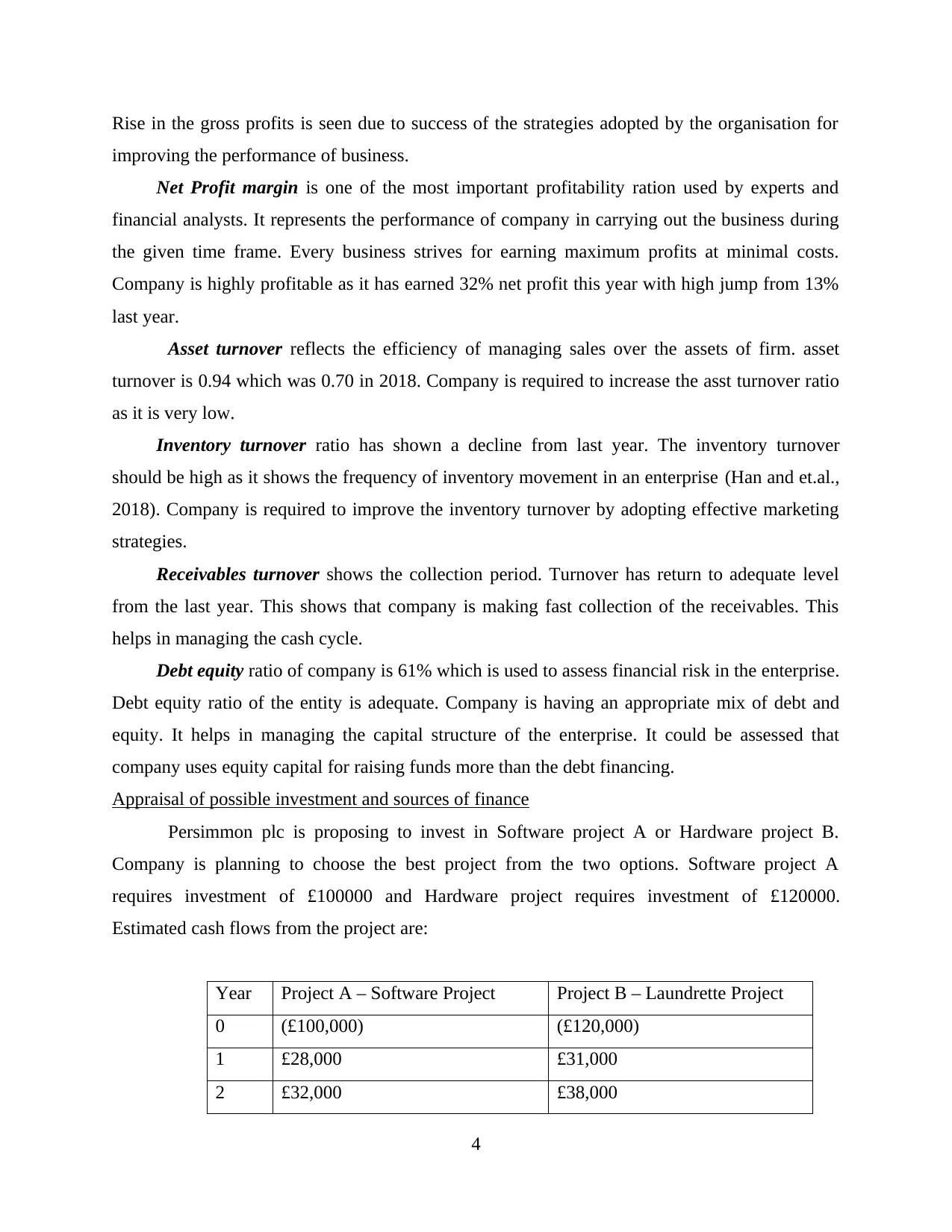
Rise in the gross profits is seen due to success of the strategies adopted by the organisation for
improving the performance of business.
Net Profit margin is one of the most important profitability ration used by experts and
financial analysts. It represents the performance of company in carrying out the business during
the given time frame. Every business strives for earning maximum profits at minimal costs.
Company is highly profitable as it has earned 32% net profit this year with high jump from 13%
last year.
Asset turnover reflects the efficiency of managing sales over the assets of firm. asset
turnover is 0.94 which was 0.70 in 2018. Company is required to increase the asst turnover ratio
as it is very low.
Inventory turnover ratio has shown a decline from last year. The inventory turnover
should be high as it shows the frequency of inventory movement in an enterprise (Han and et.al.,
2018). Company is required to improve the inventory turnover by adopting effective marketing
strategies.
Receivables turnover shows the collection period. Turnover has return to adequate level
from the last year. This shows that company is making fast collection of the receivables. This
helps in managing the cash cycle.
Debt equity ratio of company is 61% which is used to assess financial risk in the enterprise.
Debt equity ratio of the entity is adequate. Company is having an appropriate mix of debt and
equity. It helps in managing the capital structure of the enterprise. It could be assessed that
company uses equity capital for raising funds more than the debt financing.
Appraisal of possible investment and sources of finance
Persimmon plc is proposing to invest in Software project A or Hardware project B.
Company is planning to choose the best project from the two options. Software project A
requires investment of £100000 and Hardware project requires investment of £120000.
Estimated cash flows from the project are:
Year Project A – Software Project Project B – Laundrette Project
0 (£100,000) (£120,000)
1 £28,000 £31,000
2 £32,000 £38,000
4
improving the performance of business.
Net Profit margin is one of the most important profitability ration used by experts and
financial analysts. It represents the performance of company in carrying out the business during
the given time frame. Every business strives for earning maximum profits at minimal costs.
Company is highly profitable as it has earned 32% net profit this year with high jump from 13%
last year.
Asset turnover reflects the efficiency of managing sales over the assets of firm. asset
turnover is 0.94 which was 0.70 in 2018. Company is required to increase the asst turnover ratio
as it is very low.
Inventory turnover ratio has shown a decline from last year. The inventory turnover
should be high as it shows the frequency of inventory movement in an enterprise (Han and et.al.,
2018). Company is required to improve the inventory turnover by adopting effective marketing
strategies.
Receivables turnover shows the collection period. Turnover has return to adequate level
from the last year. This shows that company is making fast collection of the receivables. This
helps in managing the cash cycle.
Debt equity ratio of company is 61% which is used to assess financial risk in the enterprise.
Debt equity ratio of the entity is adequate. Company is having an appropriate mix of debt and
equity. It helps in managing the capital structure of the enterprise. It could be assessed that
company uses equity capital for raising funds more than the debt financing.
Appraisal of possible investment and sources of finance
Persimmon plc is proposing to invest in Software project A or Hardware project B.
Company is planning to choose the best project from the two options. Software project A
requires investment of £100000 and Hardware project requires investment of £120000.
Estimated cash flows from the project are:
Year Project A – Software Project Project B – Laundrette Project
0 (£100,000) (£120,000)
1 £28,000 £31,000
2 £32,000 £38,000
4
⊘ This is a preview!⊘
Do you want full access?
Subscribe today to unlock all pages.

Trusted by 1+ million students worldwide
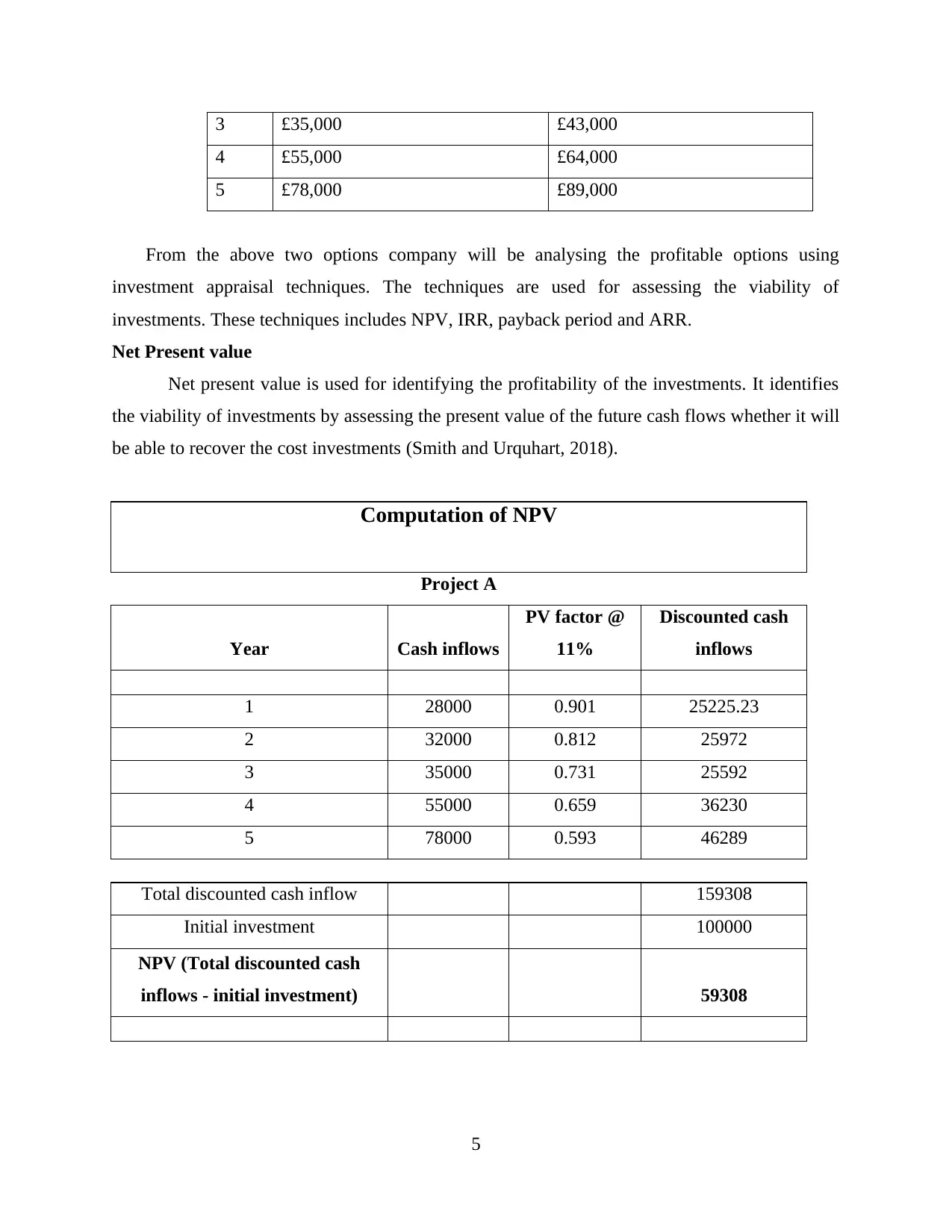
3 £35,000 £43,000
4 £55,000 £64,000
5 £78,000 £89,000
From the above two options company will be analysing the profitable options using
investment appraisal techniques. The techniques are used for assessing the viability of
investments. These techniques includes NPV, IRR, payback period and ARR.
Net Present value
Net present value is used for identifying the profitability of the investments. It identifies
the viability of investments by assessing the present value of the future cash flows whether it will
be able to recover the cost investments (Smith and Urquhart, 2018).
Computation of NPV
Project A
Year Cash inflows
PV factor @
11%
Discounted cash
inflows
1 28000 0.901 25225.23
2 32000 0.812 25972
3 35000 0.731 25592
4 55000 0.659 36230
5 78000 0.593 46289
Total discounted cash inflow 159308
Initial investment 100000
NPV (Total discounted cash
inflows - initial investment) 59308
5
4 £55,000 £64,000
5 £78,000 £89,000
From the above two options company will be analysing the profitable options using
investment appraisal techniques. The techniques are used for assessing the viability of
investments. These techniques includes NPV, IRR, payback period and ARR.
Net Present value
Net present value is used for identifying the profitability of the investments. It identifies
the viability of investments by assessing the present value of the future cash flows whether it will
be able to recover the cost investments (Smith and Urquhart, 2018).
Computation of NPV
Project A
Year Cash inflows
PV factor @
11%
Discounted cash
inflows
1 28000 0.901 25225.23
2 32000 0.812 25972
3 35000 0.731 25592
4 55000 0.659 36230
5 78000 0.593 46289
Total discounted cash inflow 159308
Initial investment 100000
NPV (Total discounted cash
inflows - initial investment) 59308
5
Paraphrase This Document
Need a fresh take? Get an instant paraphrase of this document with our AI Paraphraser

Computation of NPV
Project B
Year Cash inflows
PV
factor @
11%
Discounted
cash inflows
1 31000 0.901 27927.93
2 38000 0.812 30842
3 43000 0.731 31441
4 64000 0.659 42159
5 89000 0.593 52817
Total discounted cash inflow 185187
Initial investment 120000
NPV (Total discounted cash
inflows - initial investment) 65187
Payback Period
Payback period measures the length of time in which company will be recovering its cost
of investment.
Computation of Payback period
Project A Project B
Year
Cash
inflows
Cumulative cash
inflows
Cash
inflows
Cumulative cash
inflows
1 28000 28000 31000 31000
2 32000 60000 38000 69000
6
Project B
Year Cash inflows
PV
factor @
11%
Discounted
cash inflows
1 31000 0.901 27927.93
2 38000 0.812 30842
3 43000 0.731 31441
4 64000 0.659 42159
5 89000 0.593 52817
Total discounted cash inflow 185187
Initial investment 120000
NPV (Total discounted cash
inflows - initial investment) 65187
Payback Period
Payback period measures the length of time in which company will be recovering its cost
of investment.
Computation of Payback period
Project A Project B
Year
Cash
inflows
Cumulative cash
inflows
Cash
inflows
Cumulative cash
inflows
1 28000 28000 31000 31000
2 32000 60000 38000 69000
6
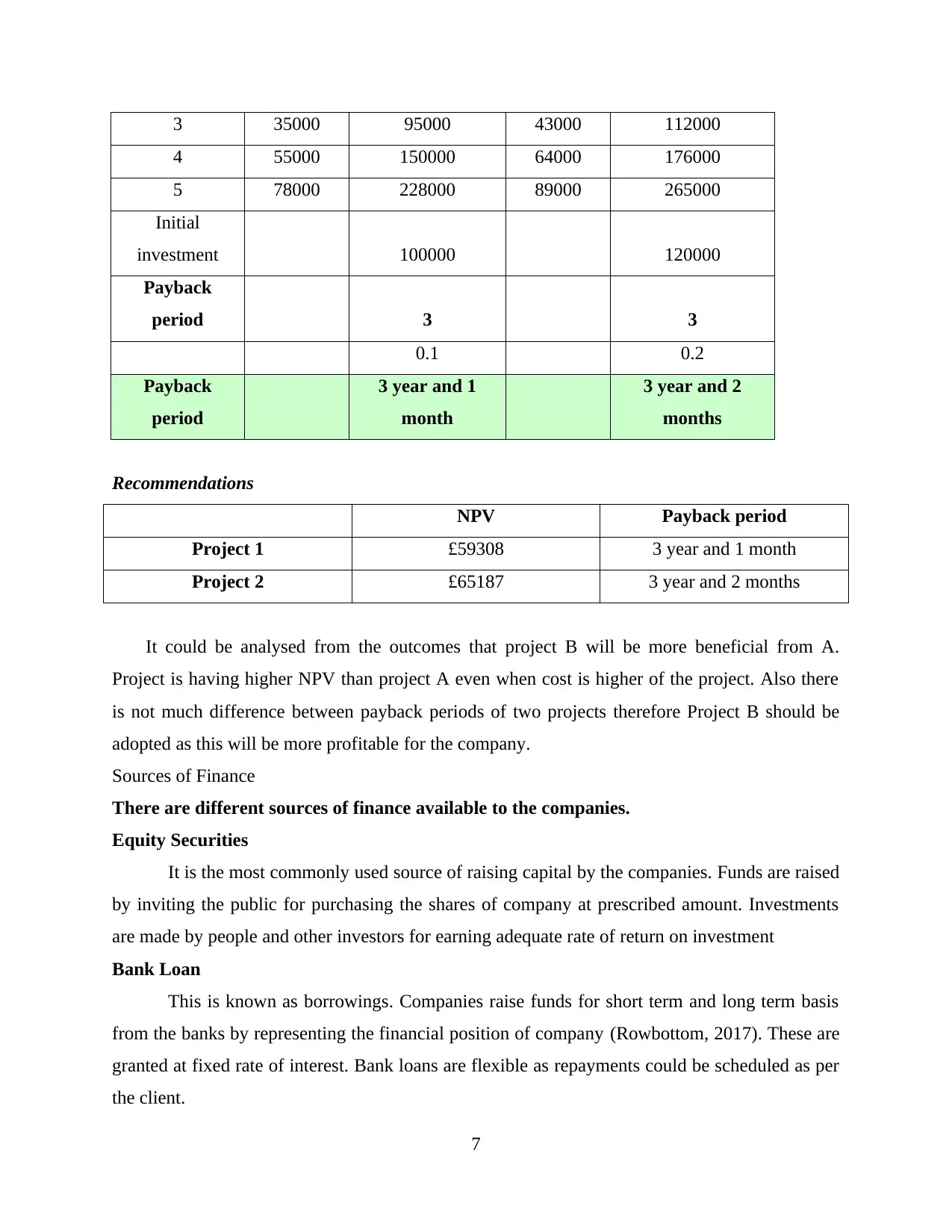
3 35000 95000 43000 112000
4 55000 150000 64000 176000
5 78000 228000 89000 265000
Initial
investment 100000 120000
Payback
period 3 3
0.1 0.2
Payback
period
3 year and 1
month
3 year and 2
months
Recommendations
NPV Payback period
Project 1 £59308 3 year and 1 month
Project 2 £65187 3 year and 2 months
It could be analysed from the outcomes that project B will be more beneficial from A.
Project is having higher NPV than project A even when cost is higher of the project. Also there
is not much difference between payback periods of two projects therefore Project B should be
adopted as this will be more profitable for the company.
Sources of Finance
There are different sources of finance available to the companies.
Equity Securities
It is the most commonly used source of raising capital by the companies. Funds are raised
by inviting the public for purchasing the shares of company at prescribed amount. Investments
are made by people and other investors for earning adequate rate of return on investment
Bank Loan
This is known as borrowings. Companies raise funds for short term and long term basis
from the banks by representing the financial position of company (Rowbottom, 2017). These are
granted at fixed rate of interest. Bank loans are flexible as repayments could be scheduled as per
the client.
7
4 55000 150000 64000 176000
5 78000 228000 89000 265000
Initial
investment 100000 120000
Payback
period 3 3
0.1 0.2
Payback
period
3 year and 1
month
3 year and 2
months
Recommendations
NPV Payback period
Project 1 £59308 3 year and 1 month
Project 2 £65187 3 year and 2 months
It could be analysed from the outcomes that project B will be more beneficial from A.
Project is having higher NPV than project A even when cost is higher of the project. Also there
is not much difference between payback periods of two projects therefore Project B should be
adopted as this will be more profitable for the company.
Sources of Finance
There are different sources of finance available to the companies.
Equity Securities
It is the most commonly used source of raising capital by the companies. Funds are raised
by inviting the public for purchasing the shares of company at prescribed amount. Investments
are made by people and other investors for earning adequate rate of return on investment
Bank Loan
This is known as borrowings. Companies raise funds for short term and long term basis
from the banks by representing the financial position of company (Rowbottom, 2017). These are
granted at fixed rate of interest. Bank loans are flexible as repayments could be scheduled as per
the client.
7
⊘ This is a preview!⊘
Do you want full access?
Subscribe today to unlock all pages.

Trusted by 1+ million students worldwide
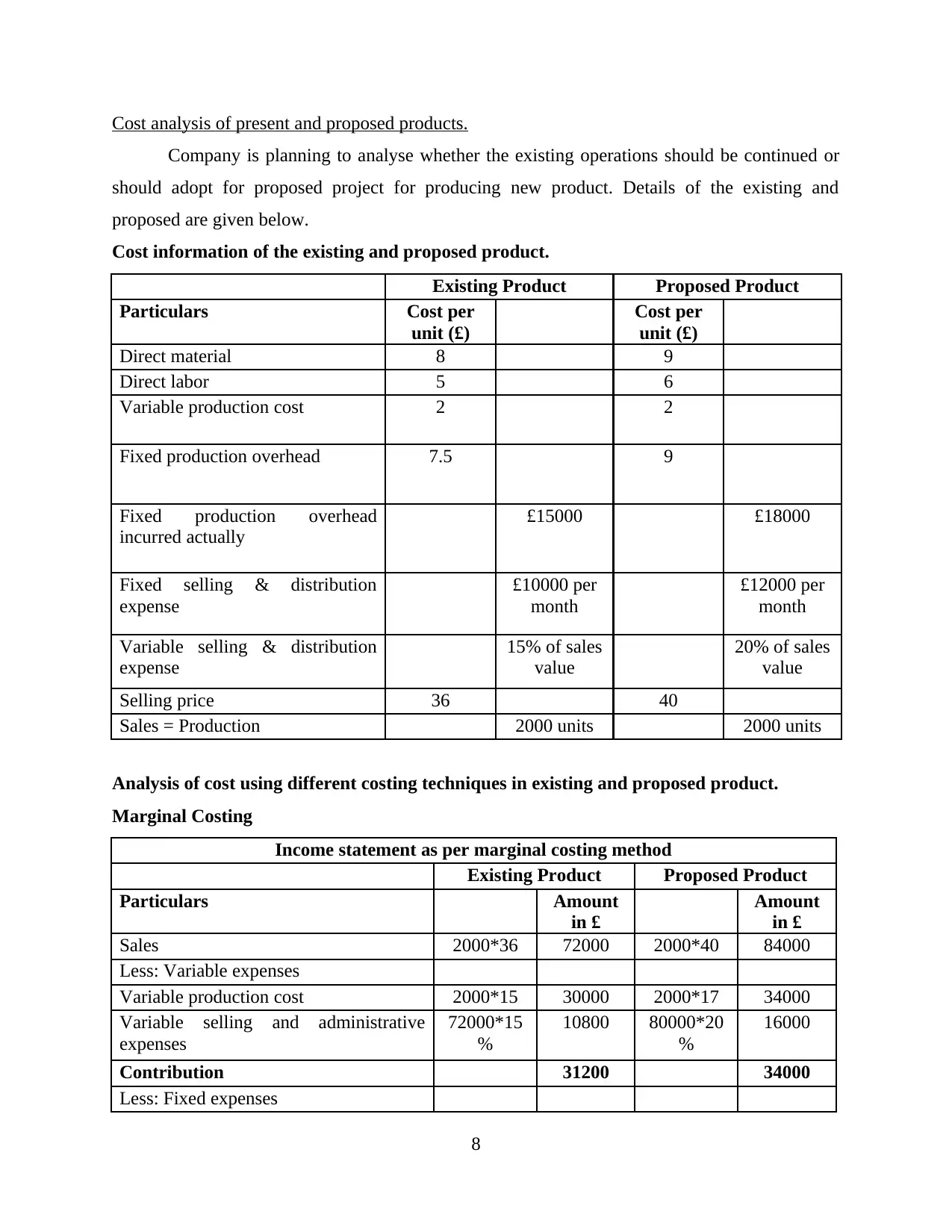
Cost analysis of present and proposed products.
Company is planning to analyse whether the existing operations should be continued or
should adopt for proposed project for producing new product. Details of the existing and
proposed are given below.
Cost information of the existing and proposed product.
Existing Product Proposed Product
Particulars Cost per
unit (£)
Cost per
unit (£)
Direct material 8 9
Direct labor 5 6
Variable production cost 2 2
Fixed production overhead 7.5 9
Fixed production overhead
incurred actually
£15000 £18000
Fixed selling & distribution
expense
£10000 per
month
£12000 per
month
Variable selling & distribution
expense
15% of sales
value
20% of sales
value
Selling price 36 40
Sales = Production 2000 units 2000 units
Analysis of cost using different costing techniques in existing and proposed product.
Marginal Costing
Income statement as per marginal costing method
Existing Product Proposed Product
Particulars Amount
in £
Amount
in £
Sales 2000*36 72000 2000*40 84000
Less: Variable expenses
Variable production cost 2000*15 30000 2000*17 34000
Variable selling and administrative
expenses
72000*15
%
10800 80000*20
%
16000
Contribution 31200 34000
Less: Fixed expenses
8
Company is planning to analyse whether the existing operations should be continued or
should adopt for proposed project for producing new product. Details of the existing and
proposed are given below.
Cost information of the existing and proposed product.
Existing Product Proposed Product
Particulars Cost per
unit (£)
Cost per
unit (£)
Direct material 8 9
Direct labor 5 6
Variable production cost 2 2
Fixed production overhead 7.5 9
Fixed production overhead
incurred actually
£15000 £18000
Fixed selling & distribution
expense
£10000 per
month
£12000 per
month
Variable selling & distribution
expense
15% of sales
value
20% of sales
value
Selling price 36 40
Sales = Production 2000 units 2000 units
Analysis of cost using different costing techniques in existing and proposed product.
Marginal Costing
Income statement as per marginal costing method
Existing Product Proposed Product
Particulars Amount
in £
Amount
in £
Sales 2000*36 72000 2000*40 84000
Less: Variable expenses
Variable production cost 2000*15 30000 2000*17 34000
Variable selling and administrative
expenses
72000*15
%
10800 80000*20
%
16000
Contribution 31200 34000
Less: Fixed expenses
8
Paraphrase This Document
Need a fresh take? Get an instant paraphrase of this document with our AI Paraphraser
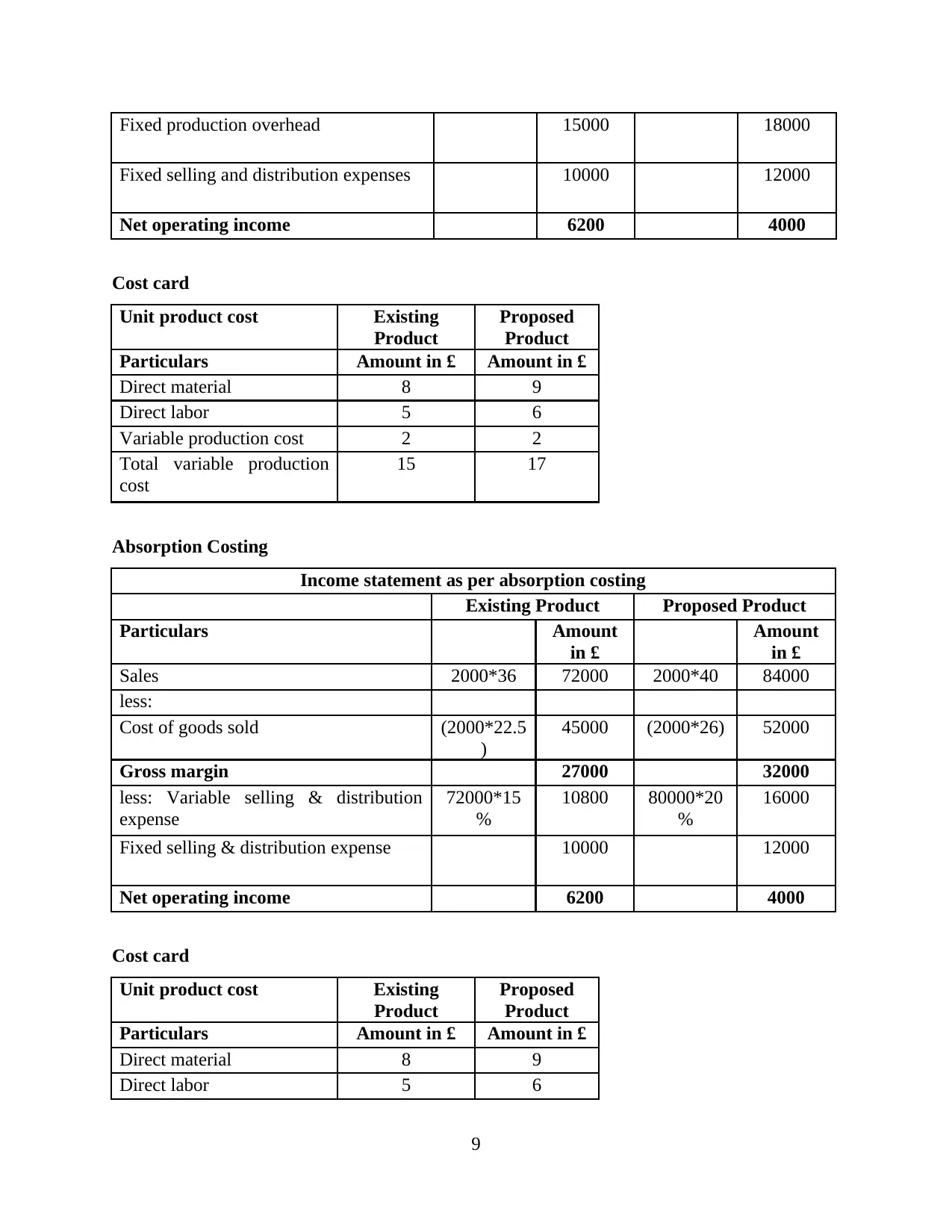
Fixed production overhead 15000 18000
Fixed selling and distribution expenses 10000 12000
Net operating income 6200 4000
Cost card
Unit product cost Existing
Product
Proposed
Product
Particulars Amount in £ Amount in £
Direct material 8 9
Direct labor 5 6
Variable production cost 2 2
Total variable production
cost
15 17
Absorption Costing
Income statement as per absorption costing
Existing Product Proposed Product
Particulars Amount
in £
Amount
in £
Sales 2000*36 72000 2000*40 84000
less:
Cost of goods sold (2000*22.5
)
45000 (2000*26) 52000
Gross margin 27000 32000
less: Variable selling & distribution
expense
72000*15
%
10800 80000*20
%
16000
Fixed selling & distribution expense 10000 12000
Net operating income 6200 4000
Cost card
Unit product cost Existing
Product
Proposed
Product
Particulars Amount in £ Amount in £
Direct material 8 9
Direct labor 5 6
9
Fixed selling and distribution expenses 10000 12000
Net operating income 6200 4000
Cost card
Unit product cost Existing
Product
Proposed
Product
Particulars Amount in £ Amount in £
Direct material 8 9
Direct labor 5 6
Variable production cost 2 2
Total variable production
cost
15 17
Absorption Costing
Income statement as per absorption costing
Existing Product Proposed Product
Particulars Amount
in £
Amount
in £
Sales 2000*36 72000 2000*40 84000
less:
Cost of goods sold (2000*22.5
)
45000 (2000*26) 52000
Gross margin 27000 32000
less: Variable selling & distribution
expense
72000*15
%
10800 80000*20
%
16000
Fixed selling & distribution expense 10000 12000
Net operating income 6200 4000
Cost card
Unit product cost Existing
Product
Proposed
Product
Particulars Amount in £ Amount in £
Direct material 8 9
Direct labor 5 6
9

Variable production cost 2 2
Total variable production
cost
15 17
Fixed production overhead 7.5 9
Unit product cost 22.5 26
Recommendation
From the above analysis it could be identified that continuing with the existing operations
will be more profitable for the company as compared with proposed product. Cost of producing
and price of products both are high where the profits are low in comparison with the existing
product. Therefore it is recommended that company should not adopt the proposed product and
continue with the existing operations of the firm.
CONCLUSION
It is summarised from the above report that Finance is concerned with the planning the
procurement an utilisation of the resources in the best manner and accounting is defined as the
art of recording financial transaction of the business. They are the most important sectors that
requires focus of the business for successful growth of business.
10
Total variable production
cost
15 17
Fixed production overhead 7.5 9
Unit product cost 22.5 26
Recommendation
From the above analysis it could be identified that continuing with the existing operations
will be more profitable for the company as compared with proposed product. Cost of producing
and price of products both are high where the profits are low in comparison with the existing
product. Therefore it is recommended that company should not adopt the proposed product and
continue with the existing operations of the firm.
CONCLUSION
It is summarised from the above report that Finance is concerned with the planning the
procurement an utilisation of the resources in the best manner and accounting is defined as the
art of recording financial transaction of the business. They are the most important sectors that
requires focus of the business for successful growth of business.
10
⊘ This is a preview!⊘
Do you want full access?
Subscribe today to unlock all pages.

Trusted by 1+ million students worldwide
1 out of 13
Related Documents
Your All-in-One AI-Powered Toolkit for Academic Success.
+13062052269
info@desklib.com
Available 24*7 on WhatsApp / Email
![[object Object]](/_next/static/media/star-bottom.7253800d.svg)
Unlock your academic potential
Copyright © 2020–2025 A2Z Services. All Rights Reserved. Developed and managed by ZUCOL.




